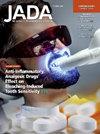评估动物辅助治疗对儿童牙科护理患者的效果
IF 3.1
2区 医学
Q1 DENTISTRY, ORAL SURGERY & MEDICINE
引用次数: 0
摘要
据估计,6%至22%的儿童患有牙齿焦虑症,这可能导致破坏性行为和逃避口腔卫生保健。来自医疗机构的证据表明,治疗犬实施后疼痛和压力减少。为了确定一种低风险、非药物治疗牙科焦虑和疼痛的方法,进行了一项前瞻性临床试验,以确定评估动物辅助治疗(AAT)疗效的最佳做法。方法通过生理、客观测量(心率、唾液皮质醇和α-淀粉酶、视频编码)和经验证的焦虑、恐惧和疼痛自我报告量表来测量AAT对儿科患者在有创牙科手术中的影响。7至14岁的儿童被连续纳入AAT组(n = 18)或对照组(n = 21)。参与者接受了手术或外科手术(如拔牙)牙科手术。采用描述性和双变量统计。结果AAT组患者术后疼痛程度明显低于对照组(P = 0.001)。在关键事件发生后,AAT参与者的心率下降,并且与对照组相比变化较小。客观视频编码显示,AAT被试下半身放松持续时间明显长于对照组(P = .204)。唾液皮质醇和α-淀粉酶无明显差异。这些生理和自我报告的测量方法在未来的研究中是可行的。结论saat可能是缓解儿童牙科患者焦虑和疼痛的有效治疗方法,值得采用客观生理终点和主观自我报告方法进行进一步研究。通过进一步的研究,犬类疗法可能是牙科诊所治疗焦虑和疼痛的一个有价值的补充。该临床试验已在ClinicalTrials.gov网站注册。注册号为NCT04708028。本文章由计算机程序翻译,如有差异,请以英文原文为准。
Evaluating effects of animal-assisted therapy on pediatric dental care patients
Background
An estimated 6% through 22% of children have dental anxiety, which can contribute to disruptive behavior and oral health care avoidance. Evidence from medical settings indicate reductions in pain and stress after therapy dog implementation. To identify a low-risk, nonpharmacologic approach for anxiety and pain management in dentistry, a pilot prospective clinical trial was conducted to determine best practices for evaluating the efficacy of animal-assisted therapy (AAT).
Methods
The effects of AAT on pediatric patients were measured through physiological, objective measures (ie, heart rate, salivary cortisol and α-amylase, and video coding) and validated self-reported scales of anxiety, fear, and pain, during an invasive dental procedure. Children aged 7 through 14 years were consecutively enrolled into an AAT (n = 18) or control (n = 21) group. Participants underwent an operative or surgical (eg, extraction) dental procedure. Descriptive and bivariate statistics were used.
Results
Participants in the AAT group reported significantly less postoperative pain than those in the control group (P = .001). The heart rates of AAT participants dropped after key events and had less variation than control participants. Objective video coding revealed that AAT participants had significantly longer durations of relaxed lower bodies than control participants (P = .204). No differences were seen in salivary cortisol and α-amylase. These physiological and self-report measures are feasible for use in future studies.
Conclusions
AAT may be an effective therapy for alleviating anxiety and pain in pediatric dental patients and warrants additional study using both objective physiological end points and subjective self-report measures.
Practical Implications
Pending further research, canine therapy may be a valuable addition to dental clinics for anxiety and pain management. This clinical trial was registered at ClinicalTrials.gov. The registration number is NCT04708028.
求助全文
通过发布文献求助,成功后即可免费获取论文全文。
去求助
来源期刊

Journal of the American Dental Association
医学-牙科与口腔外科
CiteScore
5.30
自引率
10.30%
发文量
221
审稿时长
34 days
期刊介绍:
There is not a single source or solution to help dentists in their quest for lifelong learning, improving dental practice, and dental well-being. JADA+, along with The Journal of the American Dental Association, is striving to do just that, bringing together practical content covering dentistry topics and procedures to help dentists—both general dentists and specialists—provide better patient care and improve oral health and well-being. This is a work in progress; as we add more content, covering more topics of interest, it will continue to expand, becoming an ever-more essential source of oral health knowledge.
 求助内容:
求助内容: 应助结果提醒方式:
应助结果提醒方式:


